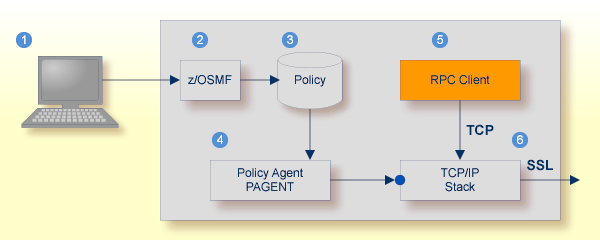RPC client applications can use Secure Sockets Layer/Transport Layer Security (SSL/TLS) as the transport medium. The term "SSL" in this section refers to both SSL and TLS. RPC-based clients are always SSL clients. The SSL server can be either the EntireX Broker, Broker SSL Agent, or Direct RPC in webMethods Integration Server (IS inbound). For an introduction see SSL/TLS and Certificates with EntireX in the Platform-independent Administration documentation.
SSL delivered on a z/OS mainframe will typically use the Resource Access Control Facility (RACF) as the certificate authority (CA). Certificates managed by RACF can only be accessed through the RACF keyring container. A keyring is a collection of certificates that identify a networking trust relationship (also called a trust policy). In an SSL client/server network environment, entities identify themselves using digital certificates called through a keyring. Server applications on z/OS that wish to establish network connections to other entities can use keyrings and their certificate contents to determine the trustworthiness of the client or peer entity. Note that certificates can belong to more than one keyring, and you can assign different users to the same keyring. Because of the way RACF internally references certificates, they must be uniquely identifiable by owner and label, and also unique by serial number plus data set name (DSN).
For establishing an SSL connection on z/OS, IBM's Application Transparent Transport Layer Security (AT-TLS) can be used, where the establishment of the SSL connection is pushed down the stack into the TCP layer.
With the PL/I Wrapper you can use IBM's Application Transparent Transport Layer Security (AT-TLS), where the establishment of the SSL connection is pushed down the stack into the TCP layer.
Configure the AT-TLS rules for the policy agent (PAGENT) ![]() using an appropriate client
using an appropriate client ![]() and the z/OS Management Facility (z/OSMF)
and the z/OS Management Facility (z/OSMF) ![]() .
Together with SSL parameters (to provide certificates stored in z/OS as RACF keyrings) define AT-TLS rules, for example by
using the application
.
Together with SSL parameters (to provide certificates stored in z/OS as RACF keyrings) define AT-TLS rules, for example by
using the application ![]() job name and remote TCP port number.
If the rules match, the TCP connection is turned into an SSL connection
job name and remote TCP port number.
If the rules match, the TCP connection is turned into an SSL connection ![]() .
Refer to your IBM documentation for more information, for example the IBM Redbook Communications Server for z/OS VxRy TCP/IP Implementation Volume 4: Security and Policy-Based Networking.
.
Refer to your IBM documentation for more information, for example the IBM Redbook Communications Server for z/OS VxRy TCP/IP Implementation Volume 4: Security and Policy-Based Networking.

| Client to interact with z/OS Management Facility (z/OSMF). | |
| AT-TLS rules are defined with z/OSMF policy management. | |
| Policy Repository with AT-TLS rules stored as z/OS files. | |
| Policy Agent, MVS task PAGENT, provides AT-TLS rules through a policy enforcement point (PEP) to TCP/IP stack. | |
| Application using TCP connection. | |
| If AT-TLS rules match, the TCP connection is turned into an SSL connection. |
Notes:
 To set up SSL with AT-TLS
To set up SSL with AT-TLS
To operate with SSL, certificates need to be provided and maintained. Depending on the platform, Software AG provides default certificates, but we strongly recommend that you create your own. See SSL/TLS Sample Certificates Delivered with EntireX in the EntireX Security documentation.
Set up the RPC component for a TCP/IP connection. On mainframe platforms, use Transport-method-style Broker ID. Example:
ETB024:1699:TCP
Configure AT-TLS to turn the TCP/IP connection to an SSL connection, see above.
Make sure the SSL server to which the RPC component connects is prepared for SSL connections as well. The SSL server can be EntireX Broker, Broker SSL Agent, or Direct RPC in webMethods Integration Server (IS inbound). See: